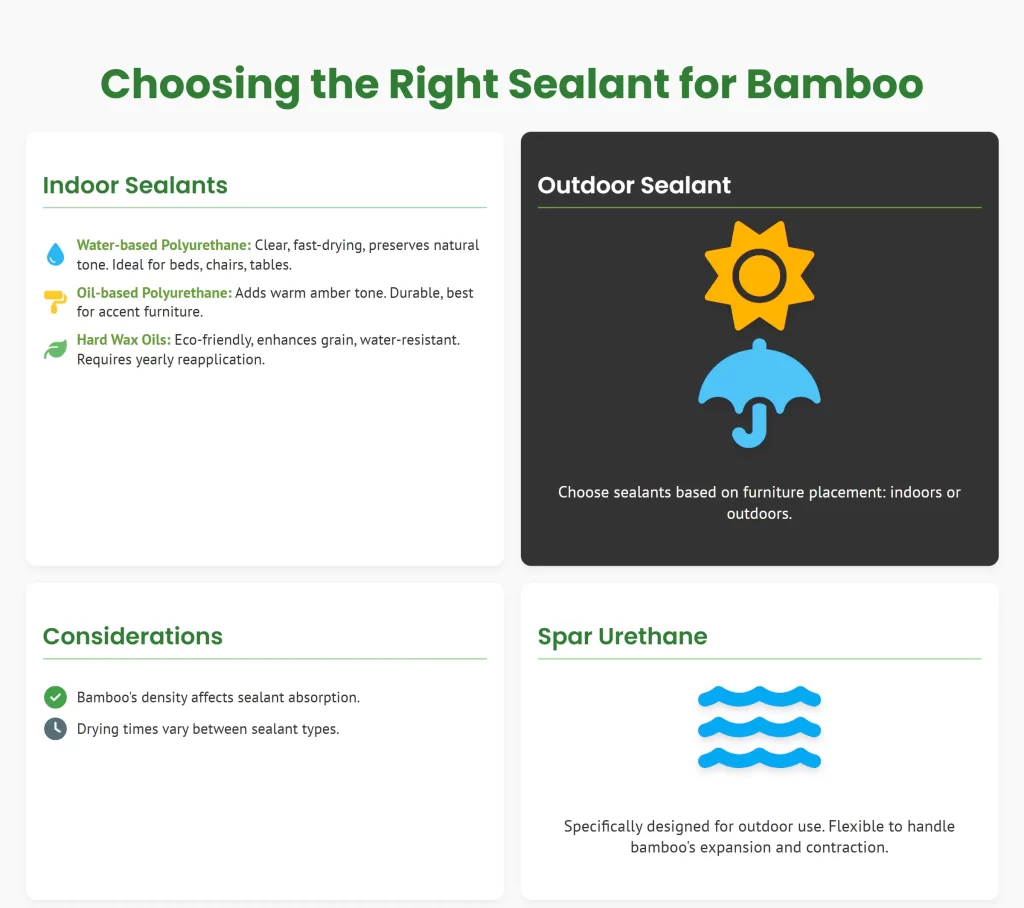This post may contain affiliate links, which means I may receive a commission for purchases made through the links. I will only recommend products that I have personally used! Learn more on my Disclosure page!
Bamboo is generous. It grows fast, holds strong, and seats you at the table or carries you through the night as a bed frame. But even generosity needs protection. Once stained, bamboo asks for one final gift: a proper seal. That clear layer decides not just how it looks today, but how it stands proud for years to come.
If you’d like the complete roadmap, from sanding to staining to final sealing, you’ll find it all inside The Bamboo Staining Bible. Think of this part of the process not as the ending, but as the shield that preserves everything you worked so hard to achieve.
Why sealing matters
Staining alone is a half‑answer. Pigments enrich bamboo with tone, but a sealant locks that color in and resists the forces waiting to strip it away. Moisture warps. Heat cracks. Dust works itself deep into tiny grooves. Once those risks start their slow attack, furniture bends toward decay.
Sealing closes the gate. A good topcoat pushes water back, hardens high‑contact areas, and stretches the lifetime of bamboo far beyond what stain alone could promise.
Without sealing, stain feels temporary. With it, the beauty becomes durable.
The types of sealants fit for bamboo

Bamboo is dense, not porous like pine or oak, which means it accepts certain finishes better than others. Over the past two years, craftspeople and DIY enthusiasts alike have settled on reliable choices:
- Water‑based polyurethane: Clear, low odor, faster drying. Keeps natural tone intact. Favored indoors for beds, chairs, and tables.
- Oil‑based polyurethane: Darkens slightly, leaving rich amber warmth. Durable, though drying time stretches longer. Suited for accent furniture.
- Spar urethane (outdoor polyurethane): Built for the elements. Flexible to handle bamboo’s natural expansion and contraction under outdoor sun and rain.
- Hard wax oils: Loved by eco‑minded creators. They resist water and enhance grain without heavy shine, though reapplication every year or two is expected.
The choice rests on furniture placement—indoors in calm living spaces, or outdoors facing seasonal battles.
How to apply sealant step by step
1. Create a clean canvas
Dust has no mercy. Wipe furniture thoroughly with a tack cloth. Vacuum the corners where particles hide. If fibers remain, they harden under sealant and mar the look forever.
2. Stir, never shake
Sealants trap bubbles if shaken. Stir them slowly and let their calm density settle.
3. First thin coat
Dip a high‑quality brush. Stroke in long lines along the bamboo grain. The coat should be thin, almost like misting color more than drowning the surface.
4. Drying time
Respect the timeline on the product label. Rushing here prevents proper bonding. In September 2025, most popular water‑based sealants on the market dry surface‑ready in about one hour, oil‑based in eight, spar urethane in four to six.
5. Sand lightly between coats
Use 320 or 400 grit. This isn’t aggression; it’s smoothing micro‑imperfections so the next coat can cling evenly.
6. Multiple layers
Two coats work for low‑traffic décor. Three to four are recommended for chairs, tabletops, and outdoor sets that endure hands, plates, and sunlight every day.
7. Curing period
Dry does not mean cured. Some sealants need up to two weeks before furniture should be fully used. Give patience now, enjoy longevity later.
Mid‑project wisdom
Here’s the truth: most heartbreaks with bamboo finishing happen here, in sealing. Either it’s skipped, rushed, or applied too thick. That’s why wisdom matters. Slow strokes, thin layers, and repeat patience.
And if you’d prefer guidance set down clearly, across every scenario, outdoor furniture care, refreshing old finishes, or choosing eco‑friendly approaches, you’ll breathe easier leaning on The Bamboo Staining Bible. It’s more than a manual, it’s like having an elder craftsman over your shoulder, whispering calm assurance every step.
Mistakes that ruin good work
- Overloading the brush leaves runs and sticky patches.
- Skipping light sanding between coats creates cloudy imperfections locked forever.
- Touching furniture too soon scuffs uncured surfaces.
- Forgetting UV protection outdoors means color fades long before structure weakens.
These aren’t dramatic errors. They’re quiet oversights. Yet they destroy hours of careful staining. A mindful sealant process saves years of regret.
Sealing bamboo outdoors vs indoors
Indoors: Choose clarity and subtlety. Water‑based polyurethane keeps tones fresh. Oil‑based adds character. Both resist daily wear.
Outdoors: The sun of 2025 is no kinder than years past. UV rays destroy fatigue lines faster than expected. That’s why spar urethane has become the dependable go‑to. It flexes as bamboo flexes, and resists rainwater that otherwise seeps into fibers.
Sealing becomes less about appearance here, and more about survival.
The deeper meaning of sealing
In truth, sealing is about trust. You’ve invested energy sanding and staining. Without a protective topcoat, you leave all that care vulnerable. The seal says: I value this piece of bamboo enough to give it longevity.
It’s like caring for a voice you want to listen to years later. Without preservation, the voice goes quiet too soon. With it, the bamboo speaks across time.
A final nudge
You’ve learned how sealing strengthens bamboo’s beauty. The workflow isn’t complicated: clean, thin coats, patience, repetition. Follow it, and bamboo stands resilient.
But if you crave confidence from first sanding grain to last protective touch, your anchor remains The Bamboo Staining Bible. It marries every stage, so each decision builds on the last. No guesswork, no shortcuts—just timeless furniture that earns admiration.
Let your bamboo last. You’ve come this far. Protect it for the years waiting ahead.